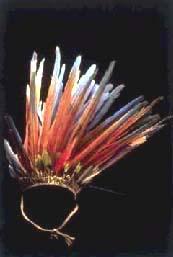We're still here
dal 23/4/2003 al 20/7/2003
Segnalato da
23/4/2003
We're still here
Virginia Museum of Fine Arts, Richmond
Photographs by Carolyn DeMerritt. 'We're still here' is the message time and again from Native Americans who today inhabit the eastern United States. These photographs tell stories, and in doing so suggest a richness of cultural experience that is unknown to many of us. The images and the text in the exhibition encourage viewers to look beyond ingrained stereotypes and learn more about the Native American cultures that enrich our American experience.

DESPITE MANY ADVERSITIES, "WE ARE STILL HERE,"
SAY NATIVE AMERICANS IN THE EASTERN U.S.
Photographs by Carolyn DeMerritt
"We're still here" is the message time and again from Native
Americans who today inhabit the eastern United States.
The message is repeated powerfully in a series of 36 selenium-toned
gelatin-silver photographs by Carolyn DeMerritt to be on view at the
Virginia Museum of Fine Arts April 24-July 20.
"The message from the Indian people is clear," says Dr. Michael
Brand, the museum's director.
"All over the East, whether in the mountains or the valleys and the
backwaters where Native American people have survived, their voices grow
stronger all the time. They celebrate, as the rest of us should too, that
they have survived against all odds."
Eileen Mott, coordinator of statewide exhibitions at the Virginia
Museum of Fine Arts, says Native Americans have faced many adversities since
the arrival of European settlers in the 16th century, among them "imported
diseases, continuing confrontations with the settlers' communities,
relocation to other areas of the country, removal of their children to
boarding schools, hostility towards the use of their own languages and many
other cultural disasters."
But, she says, "these native peoples have endured."
The exhibition, "As Long As the Waters Flow: Native Americans in the
South and East," visually documents the strength of spirit of Native
Americans east of the Mississippi as they work to build their communities
and make their presence known.
"I would like those who see the exhibition to look closely at the
faces represented in these beautiful photographs, seeing not only the
products of a skilled and sensitive artist, but beyond them, the messages of
hope and pride," Mott says.
"These photographs tell stories, and in doing so suggest a richness
of cultural experience that is unknown to many of us. The images and the
text in the exhibition encourage viewers to look beyond ingrained
stereotypes and learn more about the Native American cultures that enrich
our American experience."
DeMeritt's photographs are the result of a collaboration with writer
Frye Gaillard, who has long been interested in documenting the intersection
of white, African-American and Native-American histories in the South.
Gaillard met with tribal leaders, then wrote a book with their approval and
encouragement. He asked DeMeritt, a prolific photographer and videographer,
to help him give a face to the people he interviewed.
The book from which the exhibition is drawn, also titled "As Long As
the Waters Flow: Native Americans in the South and East," was published in
1998. (The book is available in the museum's shop for $21.95; members
receive a 10-percent discount.)
"Their efforts create inspiring portraits of Native Americans who
are speaking out to ensure that their traditions remain part of their
future," Mott says.
DeMeritt lives in Charlotte, N.C. Her work is in collections at the
National Museum of Women in the Arts in Washington, D.C., and the High
Museum of Art in Atlanta. She has received grants and awards from the North
Carolina Arts Council, the Southeast Media Fellowship Program and the
National Endowment for the Arts.
Gaillard, who wrote the text panels that accompany the exhibition,
is a native of Mobile, Ala., and lives near Charlotte, N.C. Gaillard has
written 15 books, including "If I Were a Carpenter: Twenty Years of Habitat
for Humanity," which won the Small Press award for the best book about
history, politics or current events.
"As Long As the Waters Flow: Native Americans in the South and East"
was organized by The Light Factory in Charlotte. Support for the exhibition
was provided by Philip Morris U.S.A., the Ruth Camp Campbell Foundation and
The Council of the Virginia Museum of Fine Arts. It is presented at the
Virginia Museum of Fine Arts in conjunction with "Uncommon Legacies: Native
American Art from the Peabody Essex Museum," also on view April 24-July 20.
There is an admission fee for "Uncommon Legacies," but "As Long As the
Waters Flow: Native Americans in the South and East" is free to all museum
visitors.
The Virginia Museum is also circulating the exhibition statewide as
part of "Old Dominion/New Perspectives: The Persistence and Renewal of
Southern Culture," a series of exhibitions and programs focusing on the
American South.
The Virginia Museum of Fine Arts, an educational institution of the
Commonwealth of Virginia, is Metropolitan Richmond's most popular cultural
attraction. The museum is on the Boulevard at Grove Avenue. The galleries
are open Wednesday through Sunday from 11 a.m. to 5 p.m. Visitors are
encouraged to keep the museum free to all by making a donation ($5
suggested). For additional information about exhibitions and programs,
telephone (804) 340-1400 or visit the Virginia Museum of Fine Arts Web site
Virginia Museum of Fine Arts
2800 Grove Avenue at the Boulevard
Richmond



